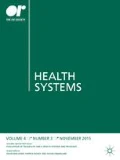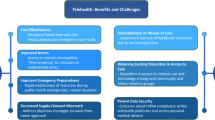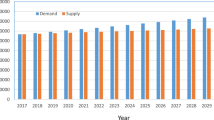Abstract
The use of optimized referral distribution strategies to improve access to specialty care is assessed. A mathematical model of a generalized care pathway is developed and the distribution of referrals is posed as an optimization problem. The objective is to minimize time from referral to a targeted stage in the care pathway (e.g., specialist consult, surgery, etc.). Numerical simulations informed by data on hip and knee surgeries demonstrate wait reductions from 21 to 38 days (16.8–30.4%) from time of referral to time of consult and from 33 to 66 days (12.6–24.7%) to time of surgery. However, the optimized referral distribution strategy minimizes wait times to the targeted stage only; wait times to non-targeted stages in the care pathway are suboptimal and may increase as an unintended consequence. Consequently, to achieve desired improvements in access, the targeted stage for wait time minimization must be carefully identified and prioritized.



Similar content being viewed by others
References
Akbari A et al (2011) Interventions to Improve Outpatient Referrals from Primary Care to Secondary Care. Cochrane Database of Systematic Reviews 2008, Issue 4. Art. No. CD005471.
Braybrooke J et al (2007) The impact of surgical wait time on patient-based outcomes in posterior lumbar spinal surgery. European Spine Journal 16(1), 1832–1839.
Bungard T et al (2009) Cardiac EASE (Ensuring access and speedy evaluation) – the impact of a single-point-of-entry multidisciplinary outpatient cardiology consultation program on wait times in Canada. Canadian Jounral of Cardiology 25(12), 697–702.
Cattani K and Schmidt G (2005) The pooling principle. INFORMS Transactions on Education 5(2), 17–24.
Cayirli TVE (2003) Outpatient scheduling in health care: a review of literature. Production and Operations Management 12(4), 519–549.
Chao J and Kalunian K (2010) Managing osteoarthritis: a multidisciplinary approach. Journal of Musculoskeletal Medicine 27(10), 1–8.
Choy E, Scott D, Kingsley G, Williams P, Wojtulewski J, Papasavvas G and Panayi G (2002) Treating rheumatoid arthritis early with disease modifying drugs reduces joint damage: a randomised double blind trial of sulphasalazine vs diclofenac sodium. Clinical and Experimental Rheumatology 20(3), 351–358.
Commonwealth Fund (2006) Framework for a High-Performance Health System for the United States. Commonwealth Fund, New York.
Conner-Spady B, Estey E, Arneet G, Ness K, McGurran J and Bear R, The Steering Commitee of the Western Canada Waiting List Project (2005) Determinants of patient and surgeon perspectives on maximum acceptable waiting times for hip and knee arthrplasty. Journal of Health Services Research and Policy 10(2), 84–90.
Conner-Spady B, Johnston G, Sanmartin C, McGurran J and Noseworthy T, The Saskatchewan Surgical Care Network/Western Canada Waiting List Project Research and Evaluation Working Group Committee. (2007a) Patient and surgeon views on maximum acceptable waiting times for joint replacement. Healthcare Policy 3(2), 102–116.
Conner-Spady B, Johnston G, Sanmartin C, McGurran J and Noseworthy T, The Saskatchewan Surgical Care Network/Western Canada Waiting List Project Research and Working Group Commitee (2007b) A bird can’t fly on one wing: patient views on waiting for hip and knee replacement surgery. Health Expectations 10(2), 108–116.
Conner-Spady B, Sanmartin C, Johnston G, McGurran J, Kehler M and Noseworthy T (2009) ‘There are too many of us to fix.’ Patients’ views of acceptable waiting times for hip and knee replacements. Journal of Health Services Research & Policy 14(4), 212–218.
Deming W (1986) Out of the Crisis. Massachusetts Institute of Technology, Cambridge.
Desmeules F, Dionne C, Belzile E, Bourbonnais R and Fremont P (2010) The burden of wait for knee replacement surgery: effects on pain, function and health-related quality of life at the time of surgery. Rheumatology 49(5), 945–954.
Dolan J (2010) Multi-criteria clinical decision support: a primer on the use ofmultiple criteria decision making methods to promote evidence based, patient-centered healthcare. Patient 3(4), 229–248.
Fyie K, Frank C, Noseworthy T, Christiansen T and Marshall D (2014) Evaluating the primary-to-specialist referral system for elective hip and knee arthroplasty. Journal of Evaluation in Clinical Practice 20(1), 66–73.
Health Quality Council of Alberta (2005) Alberta Quality Matrix for Health User Guide. Health Quality Council of Alberta, Calgary, Alberta.
Imison C and Naylor C (2010) Referral Management: Lessons for Success. The King’s Fund, London.
Institute of Medicine (2001) Crossing the Quality Chasm: A New Heallth System for the 21st Century. Institute of Medicine, Washington DC.
Klassen A, Millar A, Anderson N, Shen J, Schiariti V and O’Donnell M (2010) Performance measurement and improvement frameworks in health, education and social services: a systematic review. International Journal for Quality in Health Care 22(1), 44–69.
Li L, Badley E, MacKay C, Mosher D, Jamal A, Jones A and Bomardier C (2008) An evidence-informed, integrated framework for rheumatoid arthritis care. Arthritis and Rheumatism 58(4), 1171–1183.
Mahon J, Bourne RR and Webster-Bogaert S (2002) Health-related quality of life and mobility of patients awaiting elective total hip arthroplasty: a prospective study. Canadian Medical Association Journal 167(10), 1115–11121.
The Organisation for Economic Co-operation and Development (2010) Improving Value in Health Care: Measuring Quality. The Organisation for Economic Co-operation and Development, Paris.
van der Linden M et al (2010) Long-term impact of delay in assessment of patients with early arthritis. Arthritis and Rheumatology 62(12), 3537–3546.
Vasilakis C, Sobolev B, Kuramoto L and Levy A (2011) A simulation study of scheduling clinic appointments in surgical care: individual surgeon versus pooled lists. Journal of the Operational Research Society 58(2), 202–211.
Vos T et al (2012) Years lived with disability (YLDs) for 1160 sequelae of 289 diseases and injuries 1990–2010: a systematic analysis for the global burden of disease study 2010. The Lancet 380(9859), 2163–2196.
Wagner EH, Austin B and VonKorff M (1996) Organizing care for patients with chronic illness. The Millbank Quarterly 74(4), 511–544.
Wagner E et al (2001) Quality improvement in chronic illness care: a collaborative approach. Journal on Quality Improvement 27(2), 63–80.
World Health Organization (2000) World Health Report Health Systems: Improving Performance. WHO, Geneva.
World Health Organization (2000) Innovative Care for Chronic Conditions: Building Blocks for Action. World Health Organization, Geneva.
Acknowledgements
The authors thank the Alberta Bone and Joint Health Institute for providing the referral data on hip and knee joint replacement surgeries. DM is supported by Canada Research Chair, Health Services and Systems Research and Arthur J.E. Child Chair in Rheumatology Outcomes Research. This research received no specific grant from any funding agency in the public, commercial, or not-for-profit sectors.
Author information
Authors and Affiliations
Rights and permissions
About this article
Cite this article
Greenwood-Lee, J., Wild, G. & Marshall, D. Improving accessibility through referral management: setting targets for specialist care. Health Syst 6, 161–170 (2017). https://doi.org/10.1057/hs.2015.20
Published:
Issue Date:
DOI: https://doi.org/10.1057/hs.2015.20




